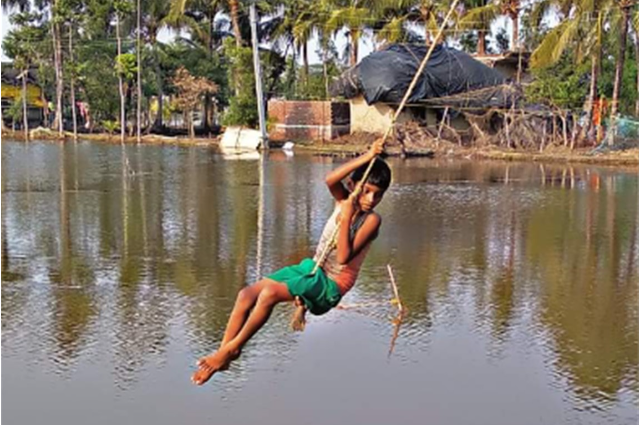
The above picture is something very mundane and usual to our Indian eyes and most definitely comes to mind when we think about the tiger ridden wildness of Sundarbans. But the curious fact about this photo is the waterbody that the kid is dangling upon in good sport, was not originally a waterbody at all. That, actually used to be a paddy field before cyclone Yaas decided to plunge it all into an enmeshed body of undrinkable water.
To the world's surprise and dismay tigers and gators and oracellas are not the only things inhabiting the fertile lands of Sundarbans. There are men and women and children living a life of uncertainty and precariousness laced with the danger of man eating tigers and powerful political parties. These men, women and children belong to the mostly ignored, overlooked, avoided even forgotten parts of the history. Then again, generally in the history of a civilization it is always the civilians that occupy the back stage.
It is once or twice in a year that Sundarbans pervade our whole consciousness. Once or twice, when the lightning strikes. The advent of monsoon in the Sundarbans is always signified by a lengthy and tumultuous cyclone or two. In 2009, Ayla the cyclone, came into the lives of the people of Sundarbans and marked the end of an era. An era of ignorant bliss. An era ended where we could go on pretending that the lives of Sundarbans' was not in constant peril. Even with the death of 200 people and 24,000 refugees on its conscience could not bring the government to realize the gravity of the danger.
Bulbul hit in 2019, Amphan in 2020 and the most recent one, Yaas, hit a few months back. The clamour and shouts and sleepless nights, efforts to protect what shred of house are left, is over. Sundarbans have somewhat gone back to its usual ways of poaching, fishing, illegal trading, clandestine politics. At least till the next cyclone strikes.
The curious thing is, after each cyclone a bunch of girls go missing from the households of villages. Sometimes they go missing willingly, sometimes not. But be sure there had been no other choice left. A human rights worker tells us, "We see these girls on the trains to Kolkata, bawling over the unfairness of destiny, but never complaining." Women get trafficked willingly here, but not by choice.
After each cyclone, one mean of earning is taken away from the people. One sweet-water pond ruined by the incoming salt water from the adjacent outlet of a river, one field of paddy destroyed by the same salt water, dead fish and carcasses of domestic animals strewn about. Livelihoods over. This is the brief summary of Sundarban life in the aftermath of a cyclone. So the women descend to the field. Pimps are not hard to find. They decide which women are suitable for which job and the most unsuitable of women you can see crouching in the platforms of railway stations, looking dazed and confused. Confused at the ceaseless torments of life. The most suitable of women end up in the renowned red light areas of Kolkata, the metro city. These women, the more suitable ones, even get to come back to their homeland, richer, with promises of jewelry and a better life. And so the cycle continues with the same rhythm. As the Sundarbans gradually, imperceptibly goes into the sea, the women of Sundarbans claw their ways out of the mud only to dance about in more filth.
After the first announcement of country-wide lockdown in India due to covid, we had seen trails of migrant laborers making their way to their native villages on foot. Swarms of men, women even children walking towards a destiny which unfolds at every turn of the highway. We had seen the police brutality on these workers. What we didn't see or know was the names of these walking dead bodies. What we did not care about before this inhuman parade of writhing, agonized people was where these people came from. They exist in our metro societies as sex workers, as domestic help, as unorganized factory workers, even as beggars. To an inexperienced set of eyes they blend right into the nameless population of metro cities and multiplex factories. But they don't belong to that, Not in truth. Among these nameless nobodies are the climate migrants of Sundarbans, forced to leave the precariousness of a hut in the face of a cyclone, forced to leave the familiar habitats, however dangerous, to feed a jobless husband and an infant. These people, in flesh, are the true stories of Sundarbans. In the housing complexes of Dhakuria, in the student abodes of Jadavpur, these stories keep on living. We only come to know about these lives when they participate in 200 kilometer long parades in hope to reach the romantic promise of a non-existent "home".
